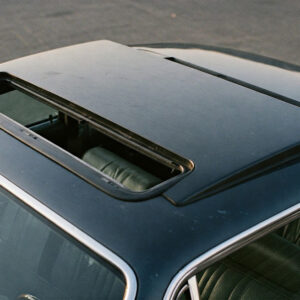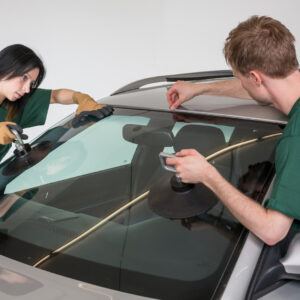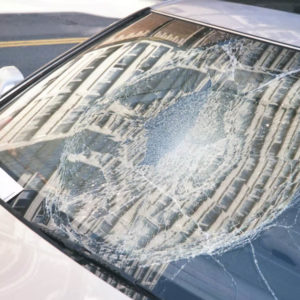
Clear visibility is essential for safe driving, and worn-out wiper blades are one of the most common and overlooked causes of poor visibility in wet or icy conditions. Over time, rubber blades crack, split, or lose contact with the windshield surface, leading to streaks, chatter, and compromised performance.
Fortunately, changing windshield wipers is a simple process that most drivers can handle with minimal tools and time. It’s a small maintenance task that makes a big difference, especially when weather conditions change suddenly. At Auto Glass Pro, our trained technicians often spot worn wipers during professional chip repairs or full windshield replacements. Timely replacement helps prevent scratches, extends glass life, and improves overall driving safety.
If you want to learn how to change windshield wipers by yourself, we’ve compiled a simple step-by-step guide from our auto glass experts below:
Step 1: Know When It’s Time to Replace Your Wipers
Wiper blades don’t fail all at once. They degrade gradually, often without notice, until visibility becomes an issue. Common signs include streaking, skipping, squeaking, or chattering across the glass. You may also see visible cracks, splitting, or uneven rubber edges when inspecting the blades. In many cases, worn wipers contribute to surface damage that can eventually lead to the need for a full windshield replacement.
Most manufacturers recommend windshield wiper replacement every six to twelve months, depending on usage and exposure to sunlight, heat, and road debris. If you’re noticing a drop in performance, it’s time to act. Replacing blades at the first sign of wear can prevent visibility issues and avoid unnecessary strain on the glass.
Step 2: Buy the Right Wiper Blades for Your Vehicle
Not all wiper blades are the same. To get the correct fit, check your owner’s manual, look up your vehicle’s specifications online, or measure the existing blades directly. Keep in mind that many vehicles use different lengths for the driver and passenger sides.
If you’re unsure about sizing, our team at Auto Glass Pro can help while you’re in for a chip repair or windshield inspection. Mismatched or incorrect blades are a common issue during car wiper replacement, and even a slight difference can lead to poor wiping performance or premature wear on the glass.
Step 3: Lift the Wiper Arm Away from the Windshield
Carefully raise the wiper arm away from the windshield until it locks in a vertical position. These arms are spring-loaded, so it’s important to handle them with control. If they snap back against the glass, even a light impact can cause chips or cracks.
To avoid accidental contact, place a folded towel or cloth on the windshield beneath the wiper. It’s a small precaution that goes a long way in protecting the glass surface.
Step 4: Remove the Old Wiper Blade
Knowing how to change windshield wiper blades starts with identifying the attachment style. A few extra seconds of attention here ensures a smooth removal and helps avoid damaging the arm or scratching the glass.
Most vehicles use a hook-style wiper arm. To remove the blade, press the small locking tab where the blade meets the arm, then slide the blade downward. It should unhook with minimal force. Be careful not to twist the arm or force the blade, as this can damage the wiper assembly.
Some vehicles use alternative mounting systems, such as pin-type or side-lock connectors. These may require a slightly different release method, often involving a small clip or push button. Refer to your vehicle’s manual if the mechanism isn’t immediately clear.
Step 5: Install the New Wiper Blade
Take the new wiper blade and align it with the arm’s attachment point. For hook-style arms, slide the blade into place until you hear or feel a distinct click. This indicates it’s securely locked in. Always double-check that the connection is firm before moving on.
If you’re learning how to install wiper blades for the first time, take your time with this step. A loose or incomplete connection can cause the blade to detach during use, especially at highway speeds.
Whether you’re tackling how to replace windshield wiper blades as routine maintenance or after a visibility issue, proper installation is key to getting full, streak-free contact with the windshield.
Step 6: Gently Lower the Arm Back onto the Windshield
Once the new blade is locked in place, lower the wiper arm carefully onto the glass. The spring tension is strong, so guide it down with control rather than letting it snap into position. Even with a new blade, abrupt contact can cause unnecessary stress to the glass. A smooth, controlled motion finishes the job cleanly.
Step 7: Test Your New Wipers
After installation, activate your washer fluid and run the wipers for a few passes. Watch for any streaks, skipping, or unusual noise. If the blades aren’t making full contact or leave uneven marks, check that they’re properly seated and facing the correct direction. A quick test ensures the blades are functioning as intended before you need them in action during poor weather conditions.
Step 8: Replace the Rear Wiper (If Applicable)
If your vehicle has a rear wiper, the replacement process follows the same basic principles as the front, but the mounting mechanism often differs. Rear wipers are typically attached using less common systems, such as:
- Side pin: A small pin slides into a channel on the blade and locks in place. You’ll usually need to press a tab or slightly pull the blade to release it.
- Bayonet: A straight metal arm inserts into the blade and twists to lock. Replacing it involves a gentle twist-and-pull motion.
- Snap-on: The blade simply snaps into a plastic arm without additional locking clips. These are easiest to install but require the right fit.
While smaller in size, rear wipers play a critical role in maintaining visibility during reversing and lane changes, especially in poor weather or winter conditions. Drivers often overlook them, but consistent performance from all wiper systems helps maintain full visual coverage around the vehicle.
Pro Tips from Auto Glass Pro Technicians
When it comes to windshield wiper replacement, we always recommend changing both blades at the same time. Replacing just one can lead to uneven cleaning and premature wear on the glass.
Routine maintenance goes a long way. Don’t wait for squeaks or streaks. Regular blade changes help preserve windshield clarity and prevent rubber breakdown that could damage the glass surface over time.
If you’re already planning a windshield repair or replacement, it’s a good time to check the condition of your wipers. Drivers often ask how to change wiper blades when visibility drops, but staying ahead of wear keeps both the glass and your line of sight in better shape year-round.
Stay Ahead of Visibility Issues with Auto Glass Pro
Changing windshield wipers is one of the simplest and most affordable ways to maintain safe driving conditions, especially during wet or unpredictable weather. A few minutes of attention can prevent streaking, glass wear, and reduced visibility when it matters most.
At Auto Glass Pro, we’re always available for full windshield replacements and chip repairs, and if you’re unsure about sizing or fit, we’re happy to help you identify the right blades while you’re in for service.Whether you’re dealing with worn rubber or a damaged windshield, don’t wait for visibility problems to escalate. Knowing how to replace wiper blades and keeping your glass in top shape is a smart, preventative step every driver should take.





